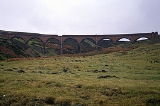
Leadhills and Wanlockhead Branch
Encyclopedia
The Leadhills and Wanlockhead Light Railway was promoted by the Caledonian Railway
, using the provisions of 1896 Light Railways Act. It opened to traffic between Elvanfoot and Leadhills
on 1 October 1901, with the remaining section to Wanlockhead
on 19 September 1902.
of 1,498 feet, it was the highest, for a standard gauge
line, in Great Britain
.
The line closed to passengers on 31 December 1938 and to freight shortly afterwards.
A significant viaduct
on the line (Rispin Cleugh viaduct) was built by Sir Robert McAlpine
. It was built from concrete
; but was clad with terracotta
bricks to improve its appearance. It was demolished with explosives in 1991 as the terracotta bricks were falling off.
A gauge tramway
crossed the line at a flat crossing to the north of Leadhills station.
, which is also a light railway
, has been built on the track formation, west from . Some terracotta bricks from the demolished viaduct were used to clad a signal box
at Leadhills station.
Caledonian Railway
The Caledonian Railway was a major Scottish railway company. It was formed in the early 19th century and it was absorbed almost a century later into the London, Midland and Scottish Railway, in the 1923 railway grouping, by means of the Railways Act 1921...
, using the provisions of 1896 Light Railways Act. It opened to traffic between Elvanfoot and Leadhills
Leadhills
Leadhills is a village in South Lanarkshire, Scotland, 5¾ miles WSW of Elvanfoot. Population 835. Originally known as Waterhead, It is the second highest village in Scotland after Wanlockhead, lying 395m above sea-level, near the source of Glengonnar Water, an affluent of the River Clyde...
on 1 October 1901, with the remaining section to Wanlockhead
Wanlockhead
Wanlockhead is a village in Dumfries and Galloway, Scotland nestling in the Lowther Hills one mile south of Leadhills at the head of the Mennock Pass, which forms part of the Southern Uplands...
on 19 September 1902.
The line
With a summitSummit (topography)
In topography, a summit is a point on a surface that is higher in elevation than all points immediately adjacent to it. Mathematically, a summit is a local maximum in elevation...
of 1,498 feet, it was the highest, for a standard gauge
Standard gauge
The standard gauge is a widely-used track gauge . Approximately 60% of the world's existing railway lines are built to this gauge...
line, in Great Britain
Great Britain
Great Britain or Britain is an island situated to the northwest of Continental Europe. It is the ninth largest island in the world, and the largest European island, as well as the largest of the British Isles...
.
The line closed to passengers on 31 December 1938 and to freight shortly afterwards.
A significant viaduct
Viaduct
A viaduct is a bridge composed of several small spans. The term viaduct is derived from the Latin via for road and ducere to lead something. However, the Ancient Romans did not use that term per se; it is a modern derivation from an analogy with aqueduct. Like the Roman aqueducts, many early...
on the line (Rispin Cleugh viaduct) was built by Sir Robert McAlpine
Sir Robert McAlpine, 1st Baronet
Sir Robert McAlpine, 1st Baronet , known as "Concrete Bob", founded the British construction firm now known as Sir Robert McAlpine Ltd....
. It was built from concrete
Concrete
Concrete is a composite construction material, composed of cement and other cementitious materials such as fly ash and slag cement, aggregate , water and chemical admixtures.The word concrete comes from the Latin word...
; but was clad with terracotta
Architectural terracotta
Terracotta, in its unglazed form, became fashionable as an architectural ceramic construction material in England in the 1860s, and in the United States in the 1870s. It was generally used to supplement brick and tiles of similar colour in late Victorian buildings.It had been used before this in...
bricks to improve its appearance. It was demolished with explosives in 1991 as the terracotta bricks were falling off.
A gauge tramway
Tramway (mineral)
Tramways are lightly laid railways, sometimes worked without locomotives. The term is in common use in the United Kingdom, New Zealand, and elsewhere. In New Zealand, they are commonly known as bush tramways...
crossed the line at a flat crossing to the north of Leadhills station.
Reuse
The narrow gauge Leadhills and Wanlockhead RailwayLeadhills and Wanlockhead Railway
The Leadhills and Wanlockhead Railway, a gauge railway in South Lanarkshire, Scotland, is laid on the trackbed of the former Leadhills and Wanlockhead Branch of the Caledonian Railway which led off the main line between and Glasgow at Elvanfoot.- Overview :...
, which is also a light railway
Light railway
Light railway refers to a railway built at lower costs and to lower standards than typical "heavy rail". This usually means the railway uses lighter weight track, and is more steeply graded and tightly curved to avoid civil engineering costs...
, has been built on the track formation, west from . Some terracotta bricks from the demolished viaduct were used to clad a signal box
Signal box
On a rail transport system, signalling control is the process by which control is exercised over train movements by way of railway signals and block systems to ensure that trains operate safely, over the correct route and to the proper timetable...
at Leadhills station.

